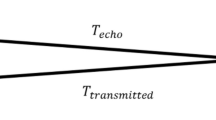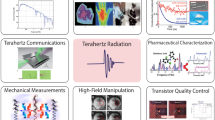Abstract
Inverse synthetic aperture radar (ISAR) imaging of target with complex motion is very important in the radar signal processing domain. In this case, the received signal can be characterized as multi-component cubic phase signal (CPS), and the high quality instantaneous ISAR images can be obtained by the parameters estimation approach. The match Fourier transform (MFT) has been proposed for the parameters estimation of linear frequency modulated (LFM) signal, and it has been used successfully in the field of ISAR imaging. In this paper, the third-order match Fourier transform (TMFT) is proposed as an extension of the traditional MFT for the parameters estimation of cubic phase signal, and the asymptotic statistical performance is analyzed theoretically with the derivation of asymptotic statistical results for the estimated parameters. Finally, the TMFT algorithm is used as a tool for the improvement of inverse synthetic aperture radar (ISAR) images quality of target with complex motion, and the results of simulated and real data validate the effectiveness of the TMFT algorithm.












Similar content being viewed by others
References
Bai, X., Tao, R., Wang, Z. J., & Wang, Y. (2014). ISAR imaging of a ship target based on parameter estimation of multicomponent quadratic frequency-modulated signals. IEEE Transactions on Geoscience and Remote Sensing, 52(2), 1418–1429.
Bao, Z., Wang, G. Y., & Luo, L. (1998). Inverse synthetic aperture radar imaging of maneuvering targets. Optical Engineering, 37(5), 1582–1588.
Chen, V. C., Lipps, R. (2000). ISAR imaging of small craft with roll, pitch and yaw analysis. In IEEE international radar conference. pp. 493–498.
Chen, V. C., & Miceli, W. J. (1998). Time-varying spectral analysis for radar imaging of maneuvering targets. IEE Proceedings-Radar, Sonar and Navigation, 145(5), 262–268.
Cohen, L. (1989). Time–frequency distribution—A review. Proceedings of IEEE, 77(7), 941–981.
Huang, Y. J., Cao, M., Fu, Y. W., Li, Y. N., & Jiang, W. D. (2009). ISAR imaging of equably accelerative rotating targets based on matching Fourier transform. Signal Processing, 25(6), 864–867. (in Chinese).
Kirkpatrik, S., Gelatt, C., & Vecchi, M. (1983). Optimization by simulated annealing. Science, 220(4598), 671–680.
Lanterman, A. D., Munson, D. C., & Wu, Y. (2003). Wide-angle radar imaging using time frequency distributions. IEE Proceedings-Radar, Sonar and Navigation, 150(4), 203–211.
Li, J., & Ling, H. (2003). Application of adaptive chirplet representation for ISAR feature extraction from targets with rotating parts. IEE Proceedings-Radar, Sonar and Navigation, 150(4), 284–291.
Liu, Z. S., Wu, R. B., & Li, J. (1999). Complex ISAR imaging of maneuvering targets via the Capon estimator. IEEE Transactions on Signal Processing, 47(5), 1262–1271.
Li, G., & Varshney, P. K. (2014). Micro-Doppler parameter estimation via parametric sparse representation and pruned orthogonal matching pursuit. IEEE Journal of Selected Topics in Applied Earth Observations and Remote Sensing, 7(12), 4937–4948.
Li, G., Zhang, H., Wang, X. Q., & Xia, X. G. (2012). ISAR 2-D imaging of uniformly rotating targets via matching pursuit. IEEE Transactions on Aerospace and Electronic Systems, 48(2), 1838–1846.
Martorella, M., Acito, N., & Berizzi, F. (2007). Statistical CLEAN technique for ISAR imaging. IEEE Transactions on Geoscience and Remote Sensing, 45(11), 3552–3560.
Ma, C. Z., Yeo, T. S., Tan, C. S., & Tan, H. S. (2010). Sparse array 3-D ISAR imaging based on maximum likelihood estimation and CLEAN technique. IEEE Transactions on Image Processing, 19(8), 2127–2142.
Pastina, D., Montanari, A., Aprile, A. (2003). Motion estimation and optimum time selection for ship ISAR imaging. In IEEE radar conference. pp. 7–14.
Peleg, S., & Porat, B. (1991). Linear FM signal parameter estimation from discrete-time observations. IEEE Transactions on Aerospace and Electronic Systems, 27(4), 607–614.
Rao, W., Li, G., Wang, X. Q., & Xia, X. G. (2013). Adaptive sparse recovery by parametric weighted L1 minimization for ISAR imaging of uniformly rotating targets. IEEE Journal of Selected Topics in Applied Earth Observations and Remote Sensing, 6(2), 942–952.
Thayaparan, T., Lampropoudos, G., Wong, S. K., & Riseborough, E. (2003). Application of adaptive joint time-frequency algorithm for focusing distorted ISAR images from simulated and measured radar data. IEE Proceedings-Radar, Sonar and Navigation, 150(4), 213–220.
Walker, J. L. (1980). Range–Doppler imaging of rotating objects. IEEE Transactions on Aerospace and Electronic Systems, 16(1), 23–52.
Wang, G. Y., Bao, Z., & Sun, X. B. (1996). Inverse synthetic aperture radar imaging of non-uniformly rotating targets. Optical Engineering, 35(10), 3007–3011.
Wang, Y., & Jiang, Y. C. (2011). Inverse synthetic aperture radar imaging of maneuvering target based on the product generalized cubic phase function. IEEE Geoscience and Remote Sensing Letters, 8(5), 958–962.
Wang, Y., & Jiang, Y. C. (2012). ISAR imaging of three-dimensional rotation target based on two-order match Fourier transform. IET Signal Processing, 6(2), 159–169.
Wang, Y., & Jiang, Y. C. (2013). Approach for high resolution inverse synthetic aperture radar imaging of ship target with complex motion. IET Signal Processing, 7(2), 146–157.
Wang, Y., Kang, J., & Jiang, Y. C. (2014). ISAR imaging of maneuvering target based on the local polynomial Wigner distribution and integrated high order ambiguity function for cubic phase signal model. IEEE Journal of Selected Topics in Applied Earth Observations and Remote Sensing, 7(7), 2971–2991.
Wang, S. L., Li, S. G., Ni, J. L., & Zhang, G. Y. (2001). A new transform-match Fourier transform. Acta electronica sinica, 29(3), 403–405.
Wang, C., Wang, Y., & Li, S. B. (2013). ISAR imaging of ship targets with complex motion based on match Fourier transform for cubic chirps model. IET Radar, Sonar and Navigation, 7(9), 994–1003.
Wang, Y., Zhao, B., & Kang, J. (2015). Asymptotic statistical performance of local polynomial Wigner distribution for the parameters estimation of cubic phase signal with application in ISAR imaging of ship target. IEEE Journal of Selected Topics in Applied Earth Observations and Remote Sensing, 8(3), 1087–1098.
Wong, S. K., Duff, G., & Riseborough, E. (2003). Distortion in the inverse synthetic aperture radar (ISAR) images of a target with time-varying perturbed motion. IEE Proceedings-Radar, Sonar and Navigation, 150(4), 221–227.
Wu, L., Wei, X. Z., Yang, D. G., Wang, H. Q., & Li, X. (2012). ISAR imaging of targets with complex motion based on discrete chirp Fourier transform for cubic chirps. IEEE Transactions on Geoscience and Remote Sensing, 50(10), 4201–4212.
Xu, W., Wang, S. L. (2007). SAR detection of moving targets based on matched Fourier transform. In 1st Asian and Pacific conference on synthetic aperture radar, pp. 289–292.
Zhang, Y., & Jiang, Y. C. (2009). A method of ISAR ship imaging based on match Fourier transform. Journal of Dalian Maritime University, 35(1), 47–52.
Zhang, Y., & Jiang, Y. C. (2009). Estimating parameters of ship echoes using match Fourier transform. Journal of Harbin Engineering University, 30(4), 447–450.
Zhang, L., Xing, M. D., Qiu, C. W., Li, J., Sheng, J. L., Li, Y. C., et al. (2010). Resolution enhancement for inversed synthetic aperture radar imaging under low SNR via improved compressive sensing. IEEE Transactions on Geoscience and Remote Sensing, 48(10), 3824–3838.
Zheng, J. B., Su, T., Zhang, L., Zhu, W. T., & Liu, Q. H. (2014). ISAR imaging of targets with complex motion based on the chirp rate-quadratic chirp rate distribution. IEEE Transactions on Geoscience and Remote Sensing, 52(11), 7276–7289.
Zheng, J. B., Su, T., Zhu, W. T., & Liu, Q. H. (2014). ISAR imaging of targets with complex motions based on the keystone time-chirp rate distribution. IEEE Geoscience and Remote Sensing Letters, 11(7), 1275–1279.
Zheng, J. B., Su, T., Zhu, W. T., Liu, Q. H., Zhang, L., & Zhu, T. W. (2013). Fast parameter estimation algorithm for cubic phase signal based on quantifying effects of Doppler frequency shift. Progress in Electromagnetics Research, 142, 57–74.
Zhu, L., Wang, S. L., Ni, J. L., & Liu, G. S. (2005). Estimation of Doppler parameter of spaceborne synthetic aperture radar by matched Fourier transform. ACTA ARMAMEN TARII, 26(3), 429–432.
Acknowledgements
This work was supported in part by the National Natural Science Foundation of China under Grant 61471149 and 61622107.
Author information
Authors and Affiliations
Corresponding author
Appendix
Appendix
The Appendix within this paper derives the asymptotic MSEs for the estimation errors in (10), and the following computations are implemented based on the first-order perturbation principle:
(1) The computation of constant A

where
For large N, we can approximate A as follows:
(2) The computation of constant B

where
For large N, we can approximate B as follows:
(3) The computation of constant C

where
For large N, we can approximate C as follows:
(4) The computation of constant D

where
For large N, we can approximate D as follows:
(5) The computation of constant E

where
For large N, we can approximate E as follows:
(6) The computation of constant F

where
For large N, we can approximate F as follows:
(7) The computation of variance of d

(8) The computation of variance of e

(9) The computation of variance of f

(10) The computation of covariance for d and e
(11) The computation of covariance for d and f
(12) The computation of covariance for f and e
By the first-order perturbation principle and combined with above definitions, the following relationship can be set up:
Then, we can obtain (10) based on the settlement of (35) and the computations from (11) to (34).
Rights and permissions
About this article
Cite this article
Wang, Y., Zhang, Q. & Zhao, B. ISAR imaging of target with complex motion based on novel approach for the parameters estimation of multi-component cubic phase signal. Multidim Syst Sign Process 29, 1285–1307 (2018). https://doi.org/10.1007/s11045-017-0503-y
Received:
Revised:
Accepted:
Published:
Issue Date:
DOI: https://doi.org/10.1007/s11045-017-0503-y




